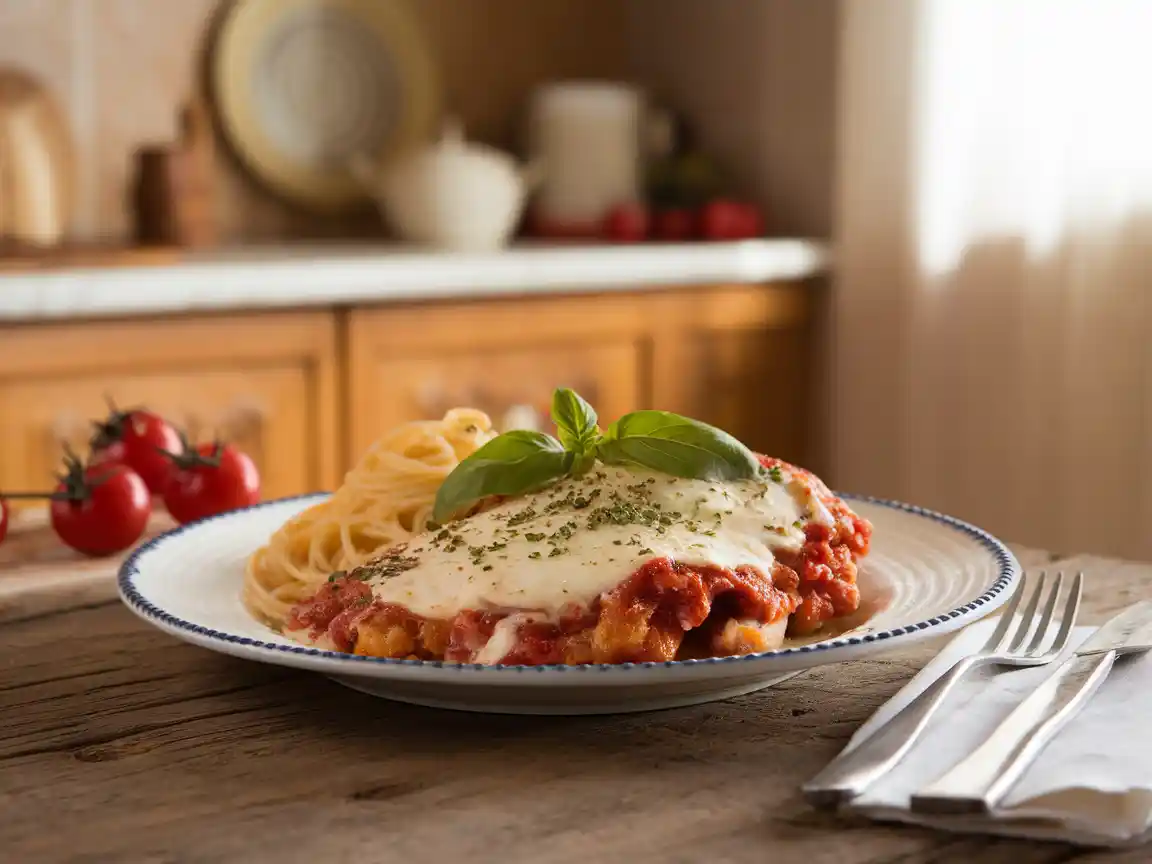Chicken Parmesan and Chicken Parmigiana—two names for a dish that’s as comforting as it is iconic. But are they the same thing, or are there subtle differences that set them apart? In this article, we’ll unravel the origins, history, and preparation techniques of these beloved recipes. Along the way, we’ll also explore why the terms are used interchangeably, their shared ingredients, and the global popularity of this Italian-American favorite. Let’s dive in!
Introduction to Chicken Parmesan and Chicken Parmigiana
A Quick Overview of the Dishes
What exactly are chicken parmesan and chicken parmigiana? At first glance, they seem identical—a breaded chicken cutlet topped with marinara sauce and melted cheese. However, the names often spark curiosity. Is it a difference in preparation, ingredients, or simply a matter of translation? Spoiler alert: they’re essentially the same dish!
The confusion arises from their roots. Chicken parmigiana hails from Italy, while chicken parmesan is the Americanized version of the name. Despite these linguistic distinctions, both dishes share the same savory, cheesy goodness that’s perfect for family dinners or restaurant menus.
Why the Terminology Matters
The debate over the names isn’t just about semantics—it’s about cultural identity and culinary evolution. Understanding what’s the difference between chicken parmesan and chicken parmigiana requires digging into their history and how they’ve traveled across continents. Beyond the kitchen, these names reveal a story of Italian traditions blending with American tastes.
Stay tuned as we uncover the fascinating origins and the slight nuances that make these dishes timeless classics. Let me know when you’re ready for Part 2, where we’ll delve into the rich history of these culinary staples!
Origins and History of Chicken Parmesan and Chicken Parmigiana
The Italian Roots: Pollo alla Parmigiana
The dish we know today as chicken parmigiana or chicken parmesan has its roots in traditional Italian cuisine. Pollo alla Parmigiana, meaning “chicken in the style of Parma,” originated in the Emilia-Romagna region of Italy. While the authentic Italian version typically uses eggplant (melanzane alla Parmigiana), it later evolved to include breaded chicken as it gained popularity globally.
Pollo alla Parmigiana was a reflection of Italy’s rich culinary heritage, emphasizing simple yet flavorful ingredients. The key components were fresh tomatoes, mozzarella cheese, and a sprinkle of Parmigiano-Reggiano—a nod to the region of Parma.
The American Influence: Italian-American Cuisine
As Italian immigrants settled in the United States, they brought their culinary traditions with them, adapting recipes to local tastes and available ingredients. In America, Pollo alla Parmigiana transformed into chicken parmesan, with breaded chicken replacing eggplant and marinara sauce providing a tangy twist.
This version quickly gained traction, especially in Italian-American restaurants, where it became synonymous with comfort food. Today, chicken parmesan is a staple on menus across the United States, reflecting a perfect blend of Italian tradition and American innovation.
Key Ingredients and Preparation Methods
Shared Ingredients and Cooking Techniques
Both chicken parmesan and chicken parmigiana rely on a few essential ingredients: breaded chicken, marinara or tomato sauce, mozzarella cheese, and Parmesan or Parmigiano-Reggiano cheese. The chicken is typically breaded with a mix of flour, egg wash, and seasoned breadcrumbs, then fried until golden and crispy.
The tomato sauce is simmered with garlic, basil, and other herbs to develop its rich flavor. Once assembled, the dish is topped with cheese and baked until the mozzarella is melted and bubbly.
Regional and Cultural Variations
While the ingredients are largely consistent, there are subtle variations based on geography. For instance, in Italy, the dish might feature a lighter sauce and more delicate flavors, while in the United States, it’s often richer and heavier, with larger portions and additional cheese.
There are also modern takes on chicken parmesan, including baked versions for a healthier twist or even one-pot dishes that simplify the cooking process.
For more delicious Italian-inspired recipes, check out this Chicken Parmesan Pasta recipe on TastySara, which showcases how traditional flavors can be adapted to suit different preferences.
Linguistic and Culinary Differences
Etymology: The Language of Parmesan vs. Parmigiana

One of the key aspects of what’s the difference between chicken parmesan and chicken parmigiana lies in their names. Parmigiana originates from the Italian term “alla Parmigiana,” which loosely translates to “in the style of Parma.” This reflects its roots in the Emilia-Romagna region of Italy, home to the famous Parmigiano-Reggiano cheese.
In contrast, chicken parmesan is the anglicized version of the name, adopted in the United States. While “parmesan” refers to the same cheese, the term is often used more generically in English-speaking countries. This linguistic adaptation mirrors the dish’s transition from traditional Italian kitchens to the broader, more casual dining landscape of America.
Modern Interpretations Across the World
As chicken parmesan and chicken parmigiana gained popularity worldwide, they evolved to suit local tastes. In Australia, for example, “parmies” or “parmas” are pub favorites, often served with fries or a side salad. In the U.S., it’s common to find chicken parmesan on sandwiches or over spaghetti, catering to the American love for hearty, carb-filled meals.
Despite these variations, the dish’s core remains the same: crispy chicken, flavorful tomato sauce, and melty cheese. These slight differences in presentation and pairing highlight how food can adapt while retaining its essence.
Popularity and Adaptations in Restaurants
Why Both Dishes are Restaurant Favorites
Whether you call it chicken parmesan or chicken parmigiana, this dish has cemented its place as a restaurant staple. Its universal appeal lies in its comforting flavors and versatility. Italian-American eateries often feature it as a signature entrée, while casual diners and pubs embrace it as an accessible yet indulgent choice.
The dish’s ability to adapt to different culinary contexts also boosts its popularity. For instance, upscale restaurants may use free-range chicken, artisanal cheeses, and house-made marinara for a refined version. Meanwhile, fast-food chains and delis offer simplified takes, such as chicken parmesan sandwiches, which appeal to those seeking a quick, satisfying meal.
Unique Twists on the Classic Recipes
Chefs worldwide have embraced chicken parmesan and chicken parmigiana, experimenting with creative twists. Some add spicy elements like chili flakes to the sauce, while others layer the chicken with prosciutto for an extra burst of flavor. Vegetarian versions, replacing chicken with eggplant or zucchini, are also gaining traction.
One popular adaptation is the baked version, which skips frying to make the dish lighter and more health-conscious. This method is particularly popular among home cooks who want to enjoy the dish without excess oil.
For a modern spin on classic flavors, check out this article on smoked chicken recipes that can inspire your next culinary adventure.
Similarities Between Chicken Parmesan and Chicken Parmigiana
Shared Ingredients and Core Cooking Methods

When considering what’s the difference between chicken parmesan and chicken parmigiana, it’s clear they share more similarities than differences. Both dishes rely on the same core ingredients: breaded chicken, tomato sauce, and melted cheese. The cooking methods are also largely identical, involving frying or baking the chicken before layering it with sauce and cheese.
The emphasis on fresh, flavorful ingredients is a hallmark of both recipes. Whether you’re using mozzarella, Parmesan, or even a mix of cheeses, the result is always a satisfying, hearty meal. The sauces in both versions are rich and tomato-based, seasoned with garlic, basil, and a pinch of oregano to enhance the flavors.
Universal Appeal Across Cultures
One reason these dishes are so popular is their versatility. They can be served over pasta, with a side salad, or even on a sandwich. This adaptability ensures they appeal to diners of all ages and preferences. Though their names differ, their essence—a combination of crispy textures and savory sauces—remains universally loved.
Conclusion and Final Thoughts
Celebrating the Versatility of These Dishes
Whether you prefer to call it chicken parmesan or chicken parmigiana, there’s no denying the enduring appeal of this dish. Its crispy breaded chicken, savory tomato sauce, and gooey cheese create a timeless flavor combination that satisfies all palates. From its Italian roots to its global popularity, this dish proves that great food knows no boundaries.
Encouraging Culinary Exploration
One of the best things about what’s the difference between chicken parmesan and chicken parmigiana is that it invites creativity in the kitchen. Whether you’re sticking to the classic recipe or trying modern adaptations, this dish offers endless opportunities for experimentation. So, grab your apron, gather some fresh ingredients, and enjoy the process of crafting your own delicious version of this iconic dish.
FAQs
Is Chicken Parmesan Really Italian?
This is a common question when discussing what’s the difference between chicken parmesan and chicken parmigiana. While the dish draws inspiration from Italian cuisine, chicken parmesan as we know it today is more of an Italian-American creation. Traditional Italian dishes like Pollo alla Parmigiana or Eggplant Parmigiana focus on lighter sauces and regional cheeses like Parmigiano-Reggiano, whereas the American version is heartier and more indulgent. So while its roots are Italian, its evolution reflects a blend of cultures.
Can Chicken Parmesan and Parmigiana Be Made Healthier?
Absolutely! For a lighter take on these classic dishes, consider baking the breaded chicken instead of frying it. Using a whole-grain breadcrumb mix or substituting zucchini or eggplant for the chicken can also cut down on calories while maintaining flavor. Another tip is to opt for a low-fat cheese blend or reduce the amount of cheese to highlight the tomato sauce’s natural flavors.
Why Are the Names Used Interchangeably?
The terms chicken parmesan and chicken parmigiana are often used interchangeably because they describe the same dish, just in different languages. “Parmesan” is the anglicized version of “Parmigiana,” and over time, the Americanized name became more common in English-speaking countries. Despite the naming differences, the dish’s comforting combination of crispy chicken, tangy tomato sauce, and melted cheese remains universally beloved

